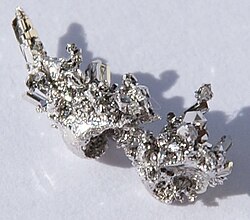Discoveries of the elements
Nickel
The use of nickel, often mistaken for copper, dates as far back as 3500 BCE. Nickel has been discovered in a dagger dating to 3100 BCE, in Egyptian iron beads, a bronze reamer found in Syria dating to 3500–3100 BCE, as copper-nickel alloys in coins minted in Bactria, in weapons and pots near the Senegal river, and as agricultural tools used by Mexicans in the 1700s. [10] [15] There is evidence to suggest that the use of nickel in antiquity came from meteoric iron, such as in the Sumerian name for iron an-bar ("fire from heaven") or in Hittite texts that describe iron's heavenly origins. Nickel was not formally named as an element until A. F. Cronstedt isolated the impure metal from "kupfernickel" (Old Nick's copper) in 1751. [11] In 1804, J. B. Richter determined the physical properties of nickel using a purer sample, describing the metal as ductile and strong with a high melting point. The strength of nickel-steel alloys were described in 1889 and since then, nickel steels saw extensive use first for military applications and then in the development of corrosion- and heat-resistant alloys during the 20th century.
Palladium
Palladium was isolated by William Hyde Wollaston in 1803 while he was working on refining platinum metals. [16] Palladium was in a residue left behind after platinum was precipitated out of a solution of hydrochloric acid and nitric acid as (NH4)PtCl6. [12] Wollaston named it after the recently discovered asteroid 2 Pallas and anonymously sold small samples of the metal to a shop, which advertised it as a "new noble metal" called "Palladium, or New Silver". [17] This raised doubts about its purity, source, and the identity of its discoverer, causing controversy. He eventually identified himself and read his paper on the discovery of palladium to the Royal Society in 1805. [18]
Platinum
Prior to its formal discovery, platinum was used in jewelry by native Ecuadorians of the province of Esmeraldas. [19] The metal was found in small grains mixed with gold in river deposits, which the workers sintered with gold to form small trinkets such as rings. The first published report of platinum was written by Antonio de Ulloa, a Spanish mathematician, astronomer, and naval officer who observed "platina" (little silver) in the gold mines of Ecuador during a French expedition in 1736. [20] Miners found the "platina" difficult to separate from gold, leading to the abandonment of those mines. Charles Wood (ironmaster) brought samples of the metal to England in 1741 and investigated its properties, observing its high melting point and its presence as small white grains in black metallic sand. Interest in the metal grew after Wood's findings were reported to the Royal Society. Henrik Teofilus Scheffer, a Swedish scientist, referred to the precious metal as "white gold" and the "seventh metal" in 1751, reporting its high durability, high density, and that it melted easily when mixed with copper or arsenic. Both Pierre-François Chabaneau (during the 1780s) and William Hyde Wollaston (during the 1800s) developed a powder metallurgy technique to produce malleable platinum, but kept their process a secret. [19] However, their platinum ingots were brittle and tended to crack easily, likely due to impurities. In the 1800s, furnaces capable of sustaining high temperatures were invented, which eventually replaced powder metallurgy and introduced melted platinum to the market.


